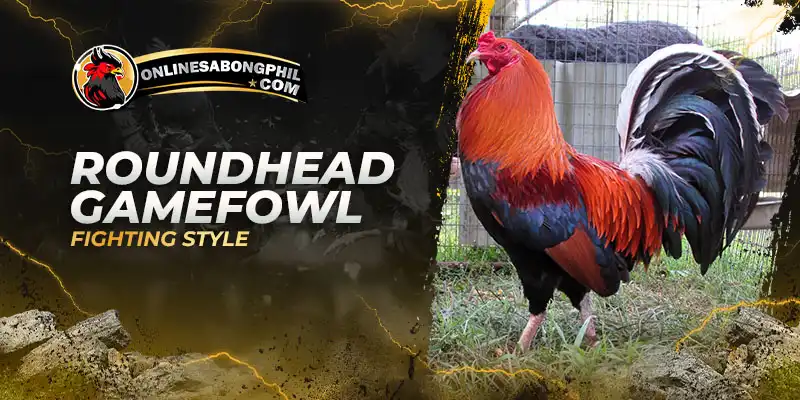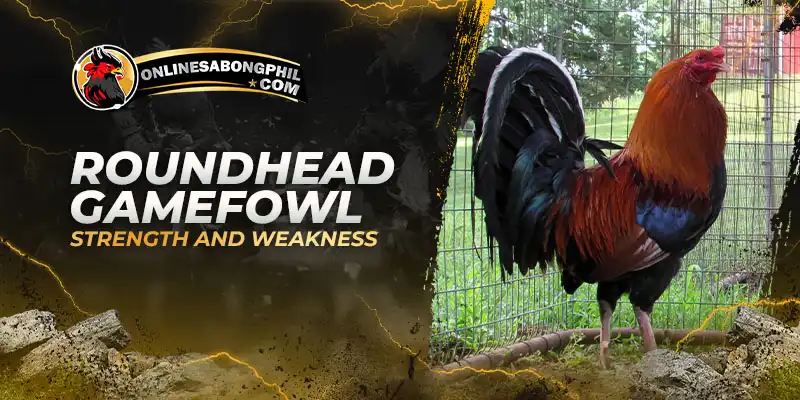The Roundhead Gamefowl is an Old English breed with a distinctive rounded head. This medium-sized bird has short legs, a compact body, and dense plumage in various colors. Known for their aggression and vital spurs, Roundheads have a long history in cockfighting. However, they can also be kept as pets or for exhibition.
Roundhead Bloodline History
The history of the Boston Roundhead gamefowl can be traced back to the 1860s when three fowl landed at the East Boston docks. John Hardwood paid for their shipping and gave them to his friend Ned Gill, who bred and fought them. Gill dubbed them “Gill Roundheads” – a name later changed to Boston Roundheads to reflect their origin. The “Roundhead” title stems from their distinctive rounded heads, a contrast to common Western fowl of the time. Their ancestry lies in Oriental breeds like the pea comb.
Roundhead gamefowl is a popular fighting rooster bloodline known for aggression, rapid strikes, and deadly cutting ability in both ground and aerial combat. Their intelligence is evident in sidesteps and agile, heads-up fighting. Initially Irish white hackles with two combs, the Roundhead breed gained size (up to five pounds) after Fred Saunders and Gris Brady introduced Oriental bloodlines.
Roundhead Gamefowl Fighting Style
Roundhead gamefowl are known for a particularly aggressive and intelligent fighting style. Here’s a breakdown of their key combat characteristics:
Speed and Agility
- Roundheads aren’t just fast in a straight line; they possess incredible agility in close quarters. Their ability to dodge, weave, and change directions suddenly throws their opponents off balance. This speed and nimbleness also let them launch attacks from unexpected angles.
Cutting Power
- A Roundhead’s gaffs are their primary weapons. Breeders focus on developing razor-sharp spurs that can inflict deep, slashing wounds with a single strike. They target vital areas, aiming to quickly disable or kill their opponent.
Ground and Air Combat
- Roundheads won’t shy away from a fight on the ground, using powerful legs to drive kicks and raking strikes. However, they are truly dangerous when airborne. They launch themselves into the air with surprising force, delivering wing buffets and slashing kicks from above.
Head-Up and Sidestepping
- A Roundhead’s signature head-up fighting style grants them a superior vision of the opponent. This allows them to anticipate strikes and react accordingly. They complement this with constant sidestepping, making themselves an incredibly elusive target.
Intelligence
- Perhaps their greatest asset is their fight intelligence. Roundheads don’t simply brawl; they analyze their opponent’s movements and weaknesses. They might feint an attack to draw a response, then capitalize on the opening. This adaptability makes them fearsome throughout a fight as they constantly adjust their strategy.
Roundhead Gamefowl Characteristic
The Roundhead Gamefowl is a distinguished breed known for its unique set of physical and behavioral traits that make it stand out among gamefowl breeds. Here is a closer look at these characteristics:
Physical Characteristics
- Rounded Head: Their most defining feature, the Roundhead boasts a distinctly rounded skull, setting it apart from other breeds.
- Compact body: They have a muscular, tightly built body with strong legs.
- Size: Medium-sized birds, typically on the smaller side of gamefowl breeds.
- Dense plumage: Smooth, tightly-packed feathers in a variety of colors including black, red, brown, white, and various combinations.
- Small comb and wattles: Designed to minimize injury in combat.
- Razor-sharp gaffs: Their spurs are a primary weapon, often honed to be incredibly sharp.
- Eye Color: Roundheads can have a variety of eye colors, with dark, reddish eyes being common.
Behavioral Characteristics
- Exceptional Aggression: Roundheads were selectively bred for aggression and fighting prowess. They are naturally territorial and ready to defend themselves.
- Intelligence: These aren’t mindless brawlers. Roundheads display a high level of intelligence in the fighting pit, able to adjust their tactics and exploit an opponent’s weaknesses.
- Athleticism: They are fast, agile, and powerful, with the ability to launch themselves into the air for dynamic aerial attacks.
- Persistence: Roundheads are known for their tenacity and willingness to fight until the very end.
- Gameness: A term specific to fighting fowl, gameness refers to an unwavering determination to continue fighting even when injured or exhausted. Roundheads are often highly game.
- Alertness: They have keen senses and are constantly aware of their surroundings.
These characteristics illustrate why the Roundhead Gamefowl is both respected and feared in the world of gamefowl competition.
Roundhead Gamefowl Strength and Weakness
The Roundhead Gamefowl, celebrated for its fighting prowess, displays a complex balance of strengths and weaknesses that are key to understanding its performance in competitive environments. Here’s a detailed breakdown of these traits:
Strengths
- Aggression and Gameness: Roundheads are incredibly aggressive and possess a strong will to fight. This makes them formidable opponents who won’t back down easily.
- Cutting Ability: Their gaffs are often incredibly sharp, allowing them to inflict severe, often fatal, wounds with a single strike.
- Speed and Agility: Roundheads are quick and agile, able to both launch swift attacks and evade their opponent’s blows.
- Aerial Combat: They excel at fighting in the air, delivering powerful wing buffets and slashing kicks from above.
- Intelligence: Their cunning and adaptability allow them to analyze an opponent’s style and capitalize on weaknesses.
Weaknesses
- Aggression as a Double-Edged Sword: While their aggression is a strength in the pit, it makes them difficult to handle and potentially dangerous for inexperienced owners.
- Smaller Size: They can be at a disadvantage against larger gamefowl breeds in terms of pure physical power.
- Susceptibility to Shuffling: Some Roundhead lines can be vulnerable to opponents that use a shuffling fighting style, making it harder for them to land their strikes accurately.
- High-Strung Nature: Their constant energy and alertness can make them more prone to nervousness than some calmer breeds.
Understanding these strengths and weaknesses provides valuable insights into the dynamics of Roundhead Gamefowl in combat and their care requirements, enhancing both their management and competitive strategy.
Conclusion
The Roundhead Gamefowl epitomizes the rich history and intricate breeding of gamefowl. Originating from the cockfighting pits of England, these birds have evolved notable traits like their distinctive round head and razor-sharp gaffs, tailored for agility and strength. While historically bred for combat, it’s important to shift focus towards their remarkable characteristics beyond fighting.
Visit us at Onlinesabongphil.com for more guides and tips!



